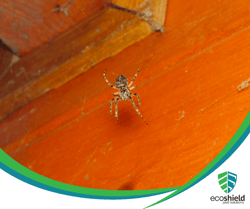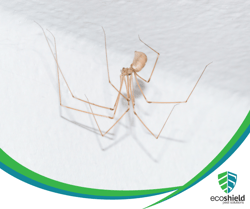 As the crisp autumn air settles in, many homeowners begin to notice an unwelcome increase in spider activity. While these eight-legged visitors play an important role in nature, no one wants them setting up residence inside their home. Fall is the prime season for spiders seeking shelter from the cooling temperatures, making it the perfect time to focus on prevention. In this post, we'll explore practical tips and strategies to keep spiders at bay, ensuring your home remains a spider-free zone throughout the cooler months.
As the crisp autumn air settles in, many homeowners begin to notice an unwelcome increase in spider activity. While these eight-legged visitors play an important role in nature, no one wants them setting up residence inside their home. Fall is the prime season for spiders seeking shelter from the cooling temperatures, making it the perfect time to focus on prevention. In this post, we'll explore practical tips and strategies to keep spiders at bay, ensuring your home remains a spider-free zone throughout the cooler months.
Why do spiders come indoors when it gets cold?
Contrary to popular belief, spiders aren't drawn indoors by warmth. In fact, they can tolerate cooler temperatures better than most pests. Instead, they move inside due to natural instincts and environmental changes in the fall. As outdoor conditions worsen, spiders seek sheltered, stable environments for survival, food, and reproduction. While most prefer the outdoors, the need for protection and a reliable food source drives them into homes during colder months.
 One reason spiders come indoors is to escape the harsh outdoor conditions. As temperatures drop, their typical habitats like leaf litter, plants, and wood piles become less hospitable. Indoor spaces, such as basements, attics, or garages, provide a sheltered environment where they are less exposed to the elements. These areas offer consistent temperatures, making it easier for spiders to thrive.
One reason spiders come indoors is to escape the harsh outdoor conditions. As temperatures drop, their typical habitats like leaf litter, plants, and wood piles become less hospitable. Indoor spaces, such as basements, attics, or garages, provide a sheltered environment where they are less exposed to the elements. These areas offer consistent temperatures, making it easier for spiders to thrive.
Another factor is the availability of food. Spiders are predators, feeding primarily on insects and other small arthropods. As colder weather drives many pests indoors, spiders follow, seeking the opportunity to hunt for their next meal. Homes that experience a surge in insects during the fall are more likely to attract spiders as well.
 Lastly, the fall season coincides with the mating period for many spider species. Male spiders, in particular, become more active in search of mates and may accidentally wander indoors during their quest. This increase in movement can explain why homeowners often see more spiders in their homes during autumn compared to other times of the year. While the idea of spiders inside the home might be unsettling, understanding why they come indoors can help in taking steps to prevent them from entering in the first place.
Lastly, the fall season coincides with the mating period for many spider species. Male spiders, in particular, become more active in search of mates and may accidentally wander indoors during their quest. This increase in movement can explain why homeowners often see more spiders in their homes during autumn compared to other times of the year. While the idea of spiders inside the home might be unsettling, understanding why they come indoors can help in taking steps to prevent them from entering in the first place.
What kind of spiders might I see in my home this fall?
As fall approaches and temperatures drop, spiders seek shelter inside homes, where the warmth and abundance of food sources make for a perfect hiding spot. Homeowners might encounter a variety of spider species this season, each with its own unique characteristics and behaviors. Here are seven common types of spiders you may find in your home this fall:
House Spider (Parasteatoda tepidariorum) – One of the most common indoor spiders, the house spider is known for its small size and round, brownish body. They build tangled, irregular webs in corners, windowsills, and other quiet areas of the home. Though they may look unsettling, house spiders are harmless and typically keep to themselves.
 Cellar Spider (Pholcidae) – Often referred to as "daddy long-legs," cellar spiders are easy to recognize due to their long, spindly legs and small, light-colored bodies. They prefer dark, damp environments like basements, crawl spaces, and attics. While their webs are messy, these spiders rarely pose any threat to humans.
Cellar Spider (Pholcidae) – Often referred to as "daddy long-legs," cellar spiders are easy to recognize due to their long, spindly legs and small, light-colored bodies. They prefer dark, damp environments like basements, crawl spaces, and attics. While their webs are messy, these spiders rarely pose any threat to humans.
Wolf Spider (Lycosidae) – Unlike web-building spiders, wolf spiders are active hunters. They are larger, with stout, hairy bodies and excellent vision, which they use to track prey. Wolf spiders may enter homes through cracks or gaps near windows and doors as they search for insects to hunt. Despite their somewhat intimidating appearance, they are not aggressive and bites are uncommon.
.png?width=250&height=210&name=Brown%20Recluse%20(1).png) Brown Recluse (Loxosceles reclusa) – Known for its venomous bite, the brown recluse can occasionally make its way into homes, particularly in southern and midwestern states. This spider is light to dark brown with a violin-shaped marking on its back. They prefer undisturbed areas like closets, basements, and storage spaces. Although bites are rare, it’s important to be cautious around this species.
Brown Recluse (Loxosceles reclusa) – Known for its venomous bite, the brown recluse can occasionally make its way into homes, particularly in southern and midwestern states. This spider is light to dark brown with a violin-shaped marking on its back. They prefer undisturbed areas like closets, basements, and storage spaces. Although bites are rare, it’s important to be cautious around this species.
Black Widow (Latrodectus) – Another venomous spider you may encounter is the black widow, easily recognized by its shiny black body and red hourglass marking on its abdomen. These spiders tend to hide in dark, secluded places like garages, woodpiles, and outdoor sheds. While their bite can be dangerous, black widows are shy and usually avoid human interaction.
Hobo Spider (Eratigena agrestis) – Common in the Pacific Northwest, the hobo spider creates funnel-shaped webs near the ground or in cracks and crevices. They have brown bodies with lighter markings and are often mistaken for other species. While they are not considered highly dangerous, their bites can cause mild irritation.
 Jumping Spider (Salticidae) – Recognizable by their compact bodies, short legs, and characteristic jumping behavior, jumping spiders are active hunters. They often enter homes through windows or doors in search of small insects. While their appearance can be startling, they are harmless and are known for their keen vision and energetic movements.
Jumping Spider (Salticidae) – Recognizable by their compact bodies, short legs, and characteristic jumping behavior, jumping spiders are active hunters. They often enter homes through windows or doors in search of small insects. While their appearance can be startling, they are harmless and are known for their keen vision and energetic movements.
Each of these spiders has its own preferred hiding spots and habits, but they all share a common goal in the fall: finding warmth and safety indoors. Understanding the types of spiders you're likely to encounter can help you identify them and take the appropriate measures to keep them out of your living spaces.
How can I effectively prevent spiders in my home?
Preventing spiders in your home this autumn requires a combination of proactive measures and professional assistance. As temperatures drop, spiders naturally seek warm, sheltered environments, which often leads them indoors. The first step in spider prevention is reducing the factors that attract them to your home. Start by keeping your space clean and free of clutter. Spiders love dark, undisturbed areas, so regular vacuuming, dusting, and clearing out forgotten corners—like closets, attics, and basements—can help discourage them from settling in. Sealing up cracks around windows, doors, and baseboards is another effective strategy, as it limits their entry points.
 In addition to these DIY solutions, it's essential to control the insects that spiders feed on. Spiders are predators, so where there’s an abundance of insects, they will follow. Make sure to minimize sources of moisture in your home, such as leaky faucets and pipes, since these attract other pests. Installing screens on windows and doors, repairing gaps, and using yellow outdoor lights can help reduce the number of insects—and, consequently, spiders—that find their way inside.
In addition to these DIY solutions, it's essential to control the insects that spiders feed on. Spiders are predators, so where there’s an abundance of insects, they will follow. Make sure to minimize sources of moisture in your home, such as leaky faucets and pipes, since these attract other pests. Installing screens on windows and doors, repairing gaps, and using yellow outdoor lights can help reduce the number of insects—and, consequently, spiders—that find their way inside.
While these efforts can significantly reduce spider activity, they may not be enough to completely eliminate the problem. That’s where professional pest control companies like EcoShield Pest Solutions come in. Experts have the tools, knowledge, and treatments necessary to thoroughly inspect your home, identify potential spider hot spots, and apply safe, effective solutions that target not only spiders but their food sources as well. By working with a professional, you can ensure a comprehensive prevention plan that keeps spiders at bay through the fall and beyond.
 Hiring a pest control service not only saves you time and effort but also provides peace of mind. Professionals like EcoShield Pest Solutions use advanced, eco-friendly treatments that are safe for your family and pets while delivering long-lasting results. They can also provide ongoing maintenance to ensure spiders and other pests don’t return once the cooler months set in. By partnering with a trusted pest control company, you can enjoy a spider-free home and avoid the stress of dealing with these unwelcome guests on your own.
Hiring a pest control service not only saves you time and effort but also provides peace of mind. Professionals like EcoShield Pest Solutions use advanced, eco-friendly treatments that are safe for your family and pets while delivering long-lasting results. They can also provide ongoing maintenance to ensure spiders and other pests don’t return once the cooler months set in. By partnering with a trusted pest control company, you can enjoy a spider-free home and avoid the stress of dealing with these unwelcome guests on your own.
Can EcoShield Pest Solutions Prevent and Remove Spiders in my Home?
Yes, EcoShield Pest Solutions can absolutely help prevent and remove spiders from your home! Our team of highly trained professionals specializes in creating custom pest control solutions designed to address the unique needs of your household. With the right combination of treatments and prevention methods, we effectively target the areas where spiders are most likely to enter and nest, ensuring that your home stays spider-free.
 Our approach starts with a thorough inspection of your home to identify potential spider hotspots. Spiders often hide in dark, secluded areas like basements, attics, and closets, as well as cracks in walls, windows, and doors. Once these areas are identified, we use eco-friendly products that are both safe for your family and tough on pests. These treatments not only eliminate any spiders currently in your home but also create a long-lasting barrier to prevent future infestations.
Our approach starts with a thorough inspection of your home to identify potential spider hotspots. Spiders often hide in dark, secluded areas like basements, attics, and closets, as well as cracks in walls, windows, and doors. Once these areas are identified, we use eco-friendly products that are both safe for your family and tough on pests. These treatments not only eliminate any spiders currently in your home but also create a long-lasting barrier to prevent future infestations.
In addition to treatment, EcoShield provides valuable recommendations for keeping spiders out long-term. This includes sealing cracks, reducing clutter, and maintaining a clean environment—especially in rooms like garages and storage spaces where spiders thrive. By combining our expert services with proactive steps, you’ll experience a dramatic reduction in spider activity, giving you peace of mind all year round.
Whether you're dealing with a current spider problem or looking to prevent one before it starts, EcoShield Pest Solutions has the tools and expertise to help. Our eco-conscious methods ensure that your home stays protected without harmful chemicals, making it safer for your family and the environment.
For fall time spider control in your home, give EcoShield a call today or fill out the form on this page to get started!